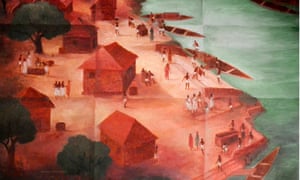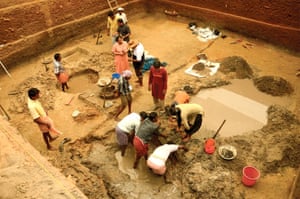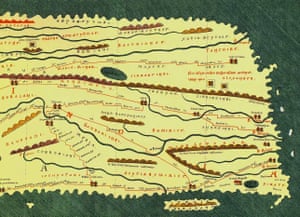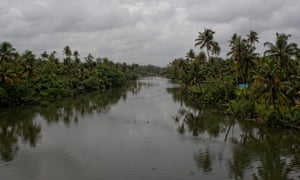By Srinath Perur in The Guardian

A painting of Muziris by the artist Ajit Kumar. In 2004, excavations in Kerala sparked new interest in this lost port. Illustration: KCHR
Around 2,000 years ago, Muziris was one of India’s most important trading ports. According to the Akananuru, a collection of Tamil poetry from the period, it was “the city where the beautiful vessels, the masterpieces of the Yavanas [Westerners], stir white foam on the Periyar, river of Kerala, arriving with gold and departing with pepper.”
Another poem speaks of Muziris (also known as Muciripattanam or Muciri) as “the city where liquor abounds”, which “bestows wealth to its visitors indiscriminately” with “gold deliveries, carried by the ocean-going ships and brought to the river bank by local boats”.
The Roman author Pliny, in his Natural History, called Muziris “the first emporium of India”. The city appears prominently on the Tabula Peutingeriana, a fifth-century map of the world as seen from Rome. But from thereon, the story of this great Indian port becomes hazy. As reports of its location grow more sporadic, it literally drops off the map.
In modern-day India, Muziris was much more of a legend than a real city – until archaeological excavations in the southern state of Kerala, starting in 2004,sparked reports of a mysterious lost port. Though the archaeologists cannot be certain, they – and, with some exceptions, historians too – now believe they have located the site of Muziris.
Around 2,000 years ago, Muziris was one of India’s most important trading ports. According to the Akananuru, a collection of Tamil poetry from the period, it was “the city where the beautiful vessels, the masterpieces of the Yavanas [Westerners], stir white foam on the Periyar, river of Kerala, arriving with gold and departing with pepper.”
Another poem speaks of Muziris (also known as Muciripattanam or Muciri) as “the city where liquor abounds”, which “bestows wealth to its visitors indiscriminately” with “gold deliveries, carried by the ocean-going ships and brought to the river bank by local boats”.
The Roman author Pliny, in his Natural History, called Muziris “the first emporium of India”. The city appears prominently on the Tabula Peutingeriana, a fifth-century map of the world as seen from Rome. But from thereon, the story of this great Indian port becomes hazy. As reports of its location grow more sporadic, it literally drops off the map.
In modern-day India, Muziris was much more of a legend than a real city – until archaeological excavations in the southern state of Kerala, starting in 2004,sparked reports of a mysterious lost port. Though the archaeologists cannot be certain, they – and, with some exceptions, historians too – now believe they have located the site of Muziris.

Excavations in the village of Pattanam, Kerala, have raised questions about whether the site is ‘urban’ enough to be Muziris. Photograph: KCHR
“This was a centre of paramount importance for Roman trade,” says Federico De Romanis, associate professor of Roman history at the University of Rome Tor Vergata. “What made it absolutely unique was the considerable amounts of black pepper exported from Muziris. We are talking about thousands of tons.”
In addition to pepper, De Romanis says, exports included both local products – ivory, pearls, spices such as malabathron – and those from other parts of India, including semi-precious stones, silks and the aromatic root nard. “These attest to commercial relationships nurtured with the Gangetic valley and east Himalayan regions.”
In the other direction, ships arrived with gold, coral, fine glassware, amphorae of wine, olive oil and the fermented fish sauce called garum. But the value of this trade was lopsided: De Romanis says Pliny the Elder estimated Rome’s annual deficit caused by imbalanced trade with India at 50m sesterces (500,000 gold coins of a little less than eight grammes), with “Muziris representing the lion’s share of it”.
Maritime trade between Muziris and Rome started in the first century BC, when it became known that sailing through the Red Sea to the horn of Africa, then due east along the 12th latitude, led to the Kerala coast. “Muziris was entirely dependent on foreign, especially Roman, demand for pepper,” De Romanis says. So when the Roman empire’s economy began to struggle in the third century AD, he believes the trade in pepper reconfigured itself, and Muziris lost its importance.

Muziris pictured (bottom right) in the Tabula Peutingeriana, a fifth-century map of the world as seen from Rome
Dr PJ Cherian, director of the Kerala Council for Historical Research, confirms there are few references to Muziris after the fifth century AD. It had been generally assumed that Muziris referred to the port of Kodungallur, which had been put out of commission by devastating floods in 1341 – but excavations there did not turn up anything older than the 13th century.
Travel 11 kilometres by road from Kodungallur, however, and you reach the village of Pattanam. For years, children there had been collecting beads that would rise to the surface during the monsoon season. After an initial dig in 2004,systematic excavations by Cherian and his colleagues began in 2007. Soon, he says, it was clear they had discovered a major archaeological site.
Over nine seasons of excavations, they have found Roman amphorae (for the first time on the Keralan coast), a wharf-like structure, a dug-out canoe that is approximately 2,000 years old – plus foundations, bricks and tiles, tools and artefacts made of iron, lead and copper, glass beads, gold ornaments and semi-precious stones clearly meant for export.
So, is Pattanam the site of fabled Muziris? There isn’t clinching evidence yet, but Cherian thinks it’s likely. He is also tired of questions about the Roman connection, asking: “When they excavate a Roman site in Europe, do they obsess similarly about whether it traded with India?” To him, an integral part of the excavation is what it reveals about the people who actually lived there.
Tathagata Neogi, of the Indian Institute of Archaeology, explains the stages of occupation in Pattanam using a large photograph of an excavated trench’s cross-section. Human habitation began there around 1000BC, marked by characteristic Iron Age black and redware pottery, while the period between 500 and 300BC marks a mixed phase.
“We think this is when Pattanam began making the transition from a village to a trade hub,” Neogi says. The period from 300BC to AD500 is densely packed with evidence for trade both within and outside India. Burnt bricks and tiles, terracotta ring wells and coins suggest a thriving settlement. Small amounts of west Asian pottery in the earlier portions of this segment provide evidence for pre-Roman maritime trade. After AD500 the record thins out – until AD1500, when Chinese and European ceramics are found.
Is Pattanam ‘urban’?
Today, Pattanam is a village situated four kilometres from the sea. The vegetation is typical of the region: tall arcing palms, squat plantains, vines and creepers, near-flourescent monsoon grass. There are sporadic houses, a temple, a village office and sudden channels of water.
The archaeological mound at Pattanam is around 70 hectares; atop it sits a museum displaying finds from the excavations. It is curious, Cherian notes, that a village should be named Pattanam, a word that means market-town or trading port across south India.
Some historians – such as Rajan Gurukkal, author of Rethinking Classical Indo-Roman Trade – have argued that Pattanam (which he believes is the location of Muziris) was likely nothing more elaborate than a colony of Mediterranean merchants, plus the inland traders and artisans who dealt with them. Gurukkal’s theory is based on the apparent absence of permanent structures, and the seeming disconnect of the materials and skills found at Pattanam with those of the wider region. He suggests the colony might even have been seasonal, inhabited only when ships arrived for trade.
Such a debate comes down to what is meant by a city or urban settlement. According to Cherian, “Urban is a complicated word – to me, it means ‘organised’, ‘thought out’, ‘planned’.” And he sees evidence of this in Pattanam: “It was certainly a city, but of its time.”
The excavations have revealed what appear to be toilets, drains and terracotta ring wells, and these – along with raised foundations aligned in one direction – suggest a planned settlement.

A channel of the Periyar river near Pattanam. Photograph: Srinath Perur
Cherian also thinks the level of technological accomplishment – the quality of mortar in a wharf structure; evidence of intricate glass and stone work – and the high density of potsherds (some 4.5 million have been recovered so far) all point to a settlement that was urban in character. The local coins suggest a monetised economy and a degree of political organisation.
“We now recognise that ancient cities could look very different from their modern counterparts, even as they had the same functions of trade and economic integration,” says Monica Smith, professor of anthropology at UCLA, who studies newly emergent urbanism in the Indian subcontinent.
“It used to be felt, by 20th-century archaeologists such as V Gordon Childe, that monumental architecture was required before a site could be defined as a ‘city’. In addition, there was often a sense that a city should have a high density of concentrated populations at their core, in which that density was focused on a particular religious or administrative purpose such as a palace or temple.”
But Smith offers an example for a more spread-out idea of a city: the large Kumbh Mela camps in India, which come up only for the duration of the congregation, are well-planned, possess infrastructure, and have an “urban atmosphere”. She adds: “We can envision that temporary or sequential occupations could have been the case in ancient cities as well.”
Smith suggests such sites can grow in extent very quickly, especially when demand for a new commodity is high (black pepper, in the case of Pattanam). “This is why research of the kind done at Pattanam is particularly important. It can help us understand the dynamic changes over time, and evaluate the extent to which investments in features such as wharves and ring wells signalled a ‘core’ location around which surrounding suburbs grew.”
A more complete understanding of the Pattanam site – and its flavour of urbanism – will take a while yet, however. According to Cherian: “Less than one percent of the site has been excavated. We have only touched the tip of the iceberg.”
The quest for Muziris may or may not be over. But as De Romanis says: “Pattanam is the closest thing to Muziris we have got so far. Whatever it was, it should be treasured and taken care of.”